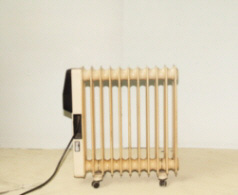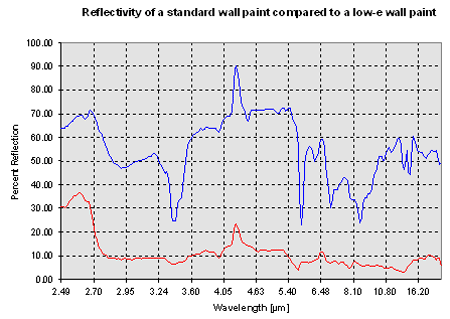Innovative Technologies for Energy Saving and Increase of Thermal Comfort
in the near and the far infrared
|
A new interior wall paint has been introduced into the market recently which not only has the properties we are used to i.e. surface protection and a nice colour, it has very specific properties in the thermal infrared as well. This new interior wall paint has been designed to reflect heat radiation at temperatures which occur in our homes, and on the other end in summer when the heat is coming from the outside it will not emit as much heat into the rooms like a regular interior wall paint. So this paint will have a positive influence on the thermal comfort in a home and finally on the yearly energy bill. As another paint will be introduced into the market very soon - which is an exterior paint and designed to reflect energy coming from the sun even when it is tinted in darker colours – it is about time to take a closer look on the physics behind these new paints before too much confusion is generated by misunderstanding or wrong interpretation of the physics. Let us first take a look at the new interior wall paint which can reflect part of the heat energy generated in a room back into it, and which will emit less heat energy into the room in summer when the sun heats up the walls on the outside. The characterizing difference of this paint is the emissivity or e-value which is lower than the e-value of regular paints and generally of most surfaces in our homes. Max Planck has found that a surface on any temperature which is higher than absolute zero (0 Kelvin, -273°C) will radiate heat energy over a specific spectrum of wavelengths. The higher the temperature the more this spectrum of radiation is shifted to shorter wavelengths. The diagram shows the radiation over wavelength of so called “blackbodies” at different temperatures. Objects on ambient temperature at 300 K or 27°C have a maximum of radiation in the thermal infrared at 10 µm or micron
The highest curve in the diagram at 5800 K represents the energy spectrum generated by the sun. For orientation the visible region of the solar spectrum is marked in the spectral or rainbow colours. An object (or surface) which radiates all of the heat energy it has is called a “blackbody”. Such a blackbody which radiates 100% of it’s energy is only theoretically possible most surfaces radiate less than that. The ratio between the energy radiated by an existing surface to the energy radiated by the blackbody describes the emissivity (ε) of that surface. The energy (E) radiated by a surface is based on its absolute temperature (T) to the fourth power, the Stefan – Boltzmann constant (σ) and is strongly controlled by it’s emissivity (ε).
The emissivities of surfaces range from below 0.1 (10%) for polished metal surfaces and over 0.9 (90%) for almost all building materials and paints. A polished metal surface with an emissivity of 0.1 will radiate only 10% of it’s heat energy to the ambient air and it will reflect 90% of heat energy coming from the ambient when it hits the surface. The best example for this behaviour is a thermos flask which is a two pane glass bottle with vacuum between the two panes where the inner sides of the two panes are metalized. The thermos flask keeps the hot coffee warm and the ice tea cold, The photographs below show two tea pots one of ceramic or porcelain and the other one of metal with a polished silver plated surface. Both have been filled with boiling hot water. The picture below was taken with a thermal imaging cam-era which makes heat rays visible. The emissivity of the porcelain tea pot is about 0.9 and we can see that it is radiating heat. The emissivity of the silver plated tea pot is below 0.1 and we can see no heat radiation here, the hotter spot on the left is the reflected heat from the porcelain tea pot. The silver plated tea pot will keep the tea hot much longer.
The new low emissive paints have very much in common with the silver plated tea pot. Besides the binder and pigments with very specific properties in the thermal infrared little metallic flakes are dispersed in the paint which act like the tea pot they reflect heat energy or emit less heat energy at ambient temperatures. The photographs below show a heater in front of a wall where the left side of the wall is painted with a regular wall paint and the right side with a low emissive paint. Again this scene has been filmed with a thermal imaging camera, and the infrared image on the right shows that the low emissive paint on the right reflects the heat radiation from the heater back into the room. This part of heat energy will not be lost to the outside whereas the regular wall paint on the left side will absorb about 90% of the heat radiation and lead it over heat conduction to the outside.
The low emissive paint increases the R-Value of the wall by changing the heat transfer coefficient in a positive way. Besides these direct energy savings the new paint increases the mean radiant temperature of the painted room which means the walls will appear warmer to the people and they could set back the thermostat which would result again in energy savings or they leave the thermostat and take advantage of a higher thermal comfort. The diagram below shows the spectral reflection of a standard wall paint (red line) compared to the reflection of a low emissive wall paint in the thermal infrared from 2.5 to 25 µm,
The reflection of the standard wall paint at wavelengths around 10 µm where surfaces on ambient temperature have their maximum of radiation is very low. Whereas the reflection of the low emissive paint is around 50%. So the diagram verifies what we have seen on the thermal image with the heater in front of the wall with the standard and the low emissive paint. A low emissive interior wall paint will save energy and increase the thermal comfort in a house in winter and in summer, so it is recommended for cold region as well as for hot regions. We have said herein before that another energy saving paint will be introduced into the market very soon. This paint is designed for the exterior walls and roofs of our homes. Everybody knows that a white paint will collect less energy from the sun whereas dark colours can really become hot when they are exposed to sunlight.
The above diagram shows the spectrum of the sun. The visible region is marked in the spectral colours, and we can see that the human eye has adapted to the highest level of solar energy. But there is quite a huge amount of energy - about 50% - beyond the visible region in the near infrared. If a paint would be black and totally absorbing in the visible, and white and totally reflective in the invisible near infrared, the solar absorption would only be 50%. Whereas a normal black paint absorbs about 90% of the solar energy and becomes very hot. It is very clear that a white roof and white wall paints would collect the lowest level of solar energy but imagine that all of our homes would be white, not very pleasing from the view point of aesthetics. Most people prefer darker colours like tile reds, blues and greens. Recently dark leathers for car seats and leather clothing especially black biker suits have been presented in the market which collect significantly less solar energy and stay much cooler when exposed to the sun compared to standard colour matched leathers.
Both ladies have been exposed to the sun for the same time and then a thermal image was taken which shows that the black leather jacket from the lady on the left is much cooler than the jacket from the lady on the right. Definitely this technology will improve the thermal comfort as it keeps the body cooler when exposed to sunlight. This technology has been adapted to metal coatings like coil coatings as well as to roof and wall coatings with the same effect that darker colours will stay much cooler than the colours matched standard colours. The photographs below show pieces of concrete roof tiles where the lower row on both images represent standard colours of roof tiles whereas the upper row represents roof tiles coated with solar reflective colours. The image on the left side shows the visual appearance of the roof tiles whereas the image on the right side has been taken with a special camera which shows the reflectance of the roof tiles in the near infrared where the sun still has 50% of its power. It is obvious that the solar reflective roof tiles will collect less energy from the sun and so stay cooler and lead less heat into the house.
The solar reflective coatings will be available as exterior wall and roof paints and as coatings for vinyl window frames shortly. The benefit of this new paint generation is besides the reduction of solar heat gains in a house and therefore an increase of thermal comfort and energy savings when an air conditioning is involved, the reduction of heat gains in the coating itself. This will lengthen the lifetime of the coating, and so save money again.
|











